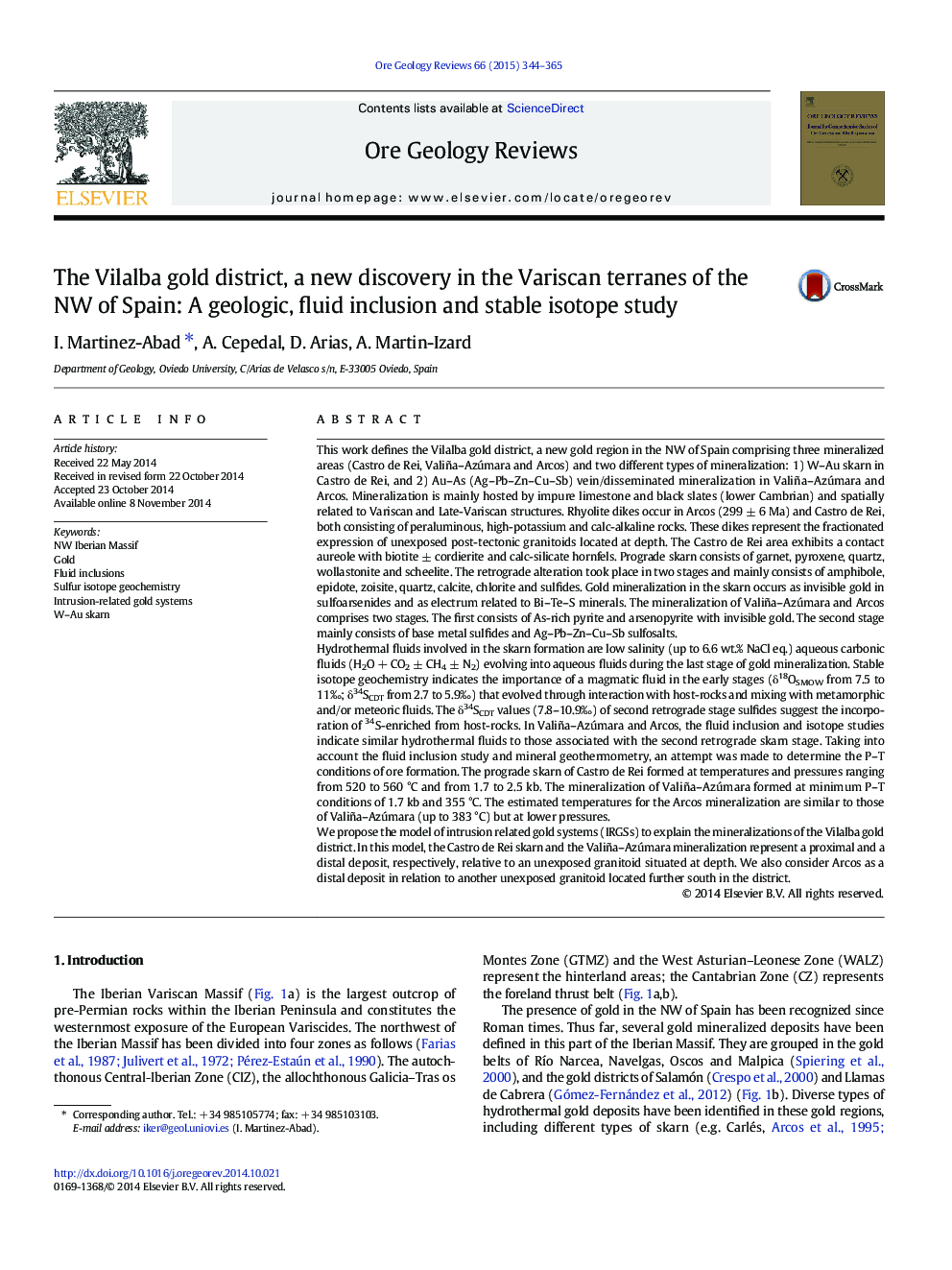| کد مقاله | کد نشریه | سال انتشار | مقاله انگلیسی | نسخه تمام متن |
|---|---|---|---|---|
| 4697183 | 1637238 | 2015 | 22 صفحه PDF | دانلود رایگان |

This work defines the Vilalba gold district, a new gold region in the NW of Spain comprising three mineralized areas (Castro de Rei, Valiña–Azúmara and Arcos) and two different types of mineralization: 1) W–Au skarn in Castro de Rei, and 2) Au–As (Ag–Pb–Zn–Cu–Sb) vein/disseminated mineralization in Valiña–Azúmara and Arcos. Mineralization is mainly hosted by impure limestone and black slates (lower Cambrian) and spatially related to Variscan and Late-Variscan structures. Rhyolite dikes occur in Arcos (299 ± 6 Ma) and Castro de Rei, both consisting of peraluminous, high-potassium and calc-alkaline rocks. These dikes represent the fractionated expression of unexposed post-tectonic granitoids located at depth. The Castro de Rei area exhibits a contact aureole with biotite ± cordierite and calc-silicate hornfels. Prograde skarn consists of garnet, pyroxene, quartz, wollastonite and scheelite. The retrograde alteration took place in two stages and mainly consists of amphibole, epidote, zoisite, quartz, calcite, chlorite and sulfides. Gold mineralization in the skarn occurs as invisible gold in sulfoarsenides and as electrum related to Bi–Te–S minerals. The mineralization of Valiña–Azúmara and Arcos comprises two stages. The first consists of As-rich pyrite and arsenopyrite with invisible gold. The second stage mainly consists of base metal sulfides and Ag–Pb–Zn–Cu–Sb sulfosalts.Hydrothermal fluids involved in the skarn formation are low salinity (up to 6.6 wt.% NaCl eq.) aqueous carbonic fluids (H2O + CO2 ± CH4 ± N2) evolving into aqueous fluids during the last stage of gold mineralization. Stable isotope geochemistry indicates the importance of a magmatic fluid in the early stages (δ18OSMOW from 7.5 to 11‰; δ34SCDT from 2.7 to 5.9‰) that evolved through interaction with host-rocks and mixing with metamorphic and/or meteoric fluids. The δ34SCDT values (7.8–10.9‰) of second retrograde stage sulfides suggest the incorporation of 34S-enriched from host-rocks. In Valiña–Azúmara and Arcos, the fluid inclusion and isotope studies indicate similar hydrothermal fluids to those associated with the second retrograde skarn stage. Taking into account the fluid inclusion study and mineral geothermometry, an attempt was made to determine the P–T conditions of ore formation. The prograde skarn of Castro de Rei formed at temperatures and pressures ranging from 520 to 560 °C and from 1.7 to 2.5 kb. The mineralization of Valiña–Azúmara formed at minimum P–T conditions of 1.7 kb and 355 °C. The estimated temperatures for the Arcos mineralization are similar to those of Valiña–Azúmara (up to 383 °C) but at lower pressures.We propose the model of intrusion related gold systems (IRGSs) to explain the mineralizations of the Vilalba gold district. In this model, the Castro de Rei skarn and the Valiña–Azúmara mineralization represent a proximal and a distal deposit, respectively, relative to an unexposed granitoid situated at depth. We also consider Arcos as a distal deposit in relation to another unexposed granitoid located further south in the district.
Journal: Ore Geology Reviews - Volume 66, April 2015, Pages 344–365